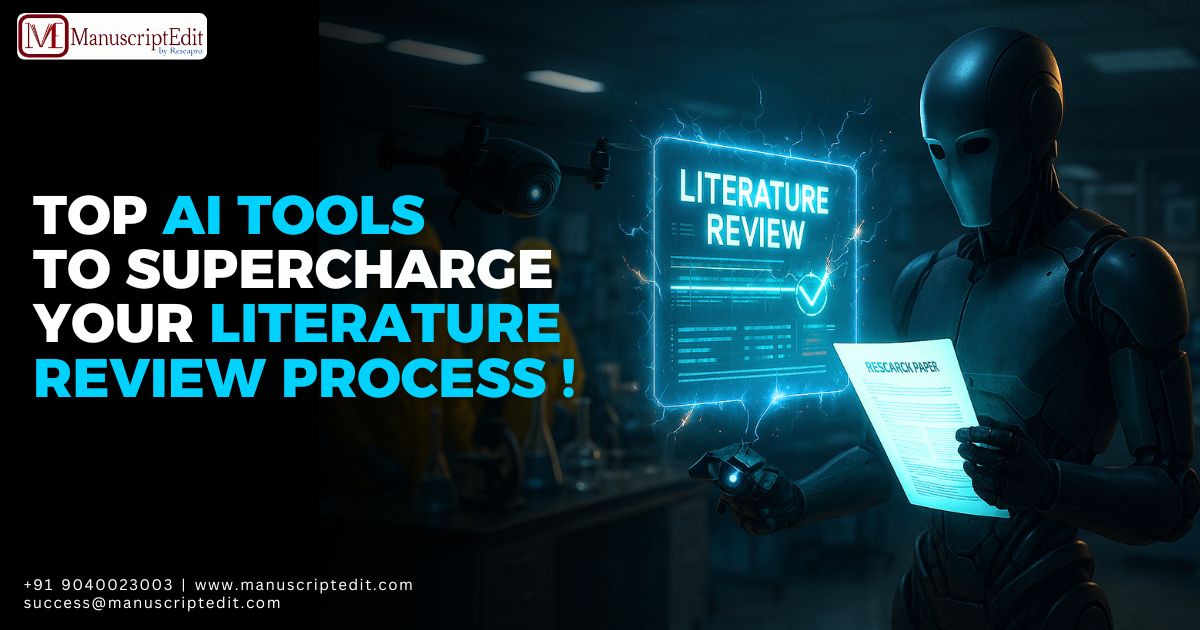|
Getting your Trinity Audio player ready...
|
Imagine cutting weeks off your literature review without sacrificing depth or rigor. With the right AI tools, you can streamline every step—from discovery to synthesis—so you can focus on insight, not paperwork.

In this guide, you will discover AI tools for literature review that researchers trust to automate tedious tasks, maintain accuracy, and deliver publication-ready summaries. Whether you are asking how to automate a literature review with AI or searching for the best AI tools for academic literature review, this article walks you through platforms, workflows, and integration tips to transform your review process.
Table of Contents
1. Introduction: Why AI in Literature Reviews?
Artificial intelligence is not here to write your paper for you—but it can make every other part of the review 10 times faster. It’s important to remember that AI tools are not a substitute for human validation and critical thinking. From identifying seminal works to extracting key findings, AI literature review software reduces manual drudgery and minimizes human error, but it’s your critical analysis and insight that give the review its depth and rigor.
- Speed: Process hundreds of abstracts in minutes, making your research process more efficient and productive.
- Coverage: Uncover connections you would otherwise miss, ensuring a comprehensive and thorough literature review.
- Consistency: Apply uniform selection criteria across studies.
You reclaim time for critical analysis, narrative crafting, and conceptual breakthroughs by leveraging AI-powered literature synthesis platforms.
2. Top AI Platforms for Literature Discovery
AI Tools for Literature Review: Summary Table
| Tool(s) | Category | Key Features | Use Case |
| Elicit | Discovery | • AI‐driven Q&A on open-access literature • Ranked paper list • Extracted key findings & gaps | Fast identification of relevant studies and literature gaps |
| Semantic Scholar | Discovery & Mapping | • Citation velocity & influence metrics • Smart filters • Citation graphs | Building systematic search strategies and spotting emerging trends |
| Connected Papers & ResearchRabbit | Discovery & Visualization | • Graph‐based related‐paper maps • Clustering by themes • Exploration of indirect references | Defining topic boundaries and uncovering thematic subfields |
| Scholarly | Summarization | • Instant PDF summarization • Flashcards of key findings • Tables of methods & outcomes | Rapid extraction of study details to prioritize full‐text reading |
| Iris.ai | Summarization & Clustering | • Semantic concept extraction • Automated clustering by theme/method • Transcript‐to‐evidence maps | Thematic synthesis and draft outline generation |
| Zotero & EndNote (+ AI plugins) | Reference Management | • AI citation suggestions • Auto‐update journal styles • Duplicate detection | Streamlined, error-free citation formatting |
| SciWheel & Colwiz | Collaborative Reference Mgt | • AI‐powered library search • Auto‐fill metadata • Shared annotated libraries | Team‐based systematic review reference organization |
2.1 Elicit
Elicit uses language models to answer research questions by scanning open‐access articles. Type your query—e.g., “What biomarkers predict early-stage Alzheimer’s?”—and Elicit returns:
- A ranked list of papers
- Extracted key findings (sample sizes, effect sizes)
- Gaps identified in the literature
Why use it? You avoid sifting through endless search results and get instant summaries. This is a game-changer for researchers asking, “How to automate literature review with AI?”
2.2 Semantic Scholar
Semantic Scholar’s AI-enhanced engine indexes millions of publications and builds citation graphs. Key features include:
- Citation velocity: Discover emerging trends before they mainstream.
- Influential citations: Highlight high-impact papers you might miss.
- Smart filters: Refine by methods, publication year, or keywords.
By visualizing connections, Semantic Scholar helps you design a systematic search strategy and ensures your review covers foundational and cutting-edge work.
2.3 Connected Papers & ResearchRabbit
These tools generate graph-based maps of related papers. Enter a seed article, and they will show:
- Direct and indirect references
- Clusters of thematic subfields
- Unexplored branches ripe for review
If you have ever struggled to define a topic’s boundaries, Connected Papers, and ResearchRabbit offer intuitive visualization—an essential step in planning a comprehensive review.
3. AI for Automated Summarization & Synthesis
3.1 Scholar
Scholarly instantly summarises full-text PDFs into:
- Bullet-point flashcards of key findings
- Tables of methods, sample sizes, and outcomes
- Highlighted novelty statements
Instead of reading 20 articles front to back, you can use scholarly summaries in minutes to decide which papers merit deeper review.
3.2 Iris.ai
Iris.ai applies semantic analysis to extract and cluster concepts across documents. Features include:
- Concept extraction: Identify recurring themes (e.g., “immune checkpoint inhibitors”).
- Automated clustering: Group papers by methodology or findings.
- Transcript mapping: Align research questions with evidence clusters.
By automating synthesis, Iris.ai supports the efficient drafting of thematic subsections for your review.
4. AI-Driven Reference Management
4.1 Zotero & EndNote with AI Plugins
Traditional reference managers now integrate AI to:
- Suggest citations as you write
- Automatically update reference styles to journal requirements
- Detect duplicates and merge entries
Plugins like Zotero’s SciWheel Connector or EndNote’s Manuscript Matcher reduce formatting errors and free you from manual editing.
Platforms designed for collaborative teams, SciWheel and Colwiz offer:
- Intelligent search within your library using AI
- Auto-fill metadata for PDFs
- Real-time sharing of annotated references
For systematic reviews where consistency is critical, AI-assisted reference management ensures you never miss a key citation.
5. Integrating AI Outputs into Your Writing Workflow
5.1 Validate AI-Generated Insights
AI can misinterpret nuances. Always:
- Cross-check extracted data with original articles.
- Confirm methodological details (e.g., sample characteristics).
- Verify statistical claims before inclusion.
This step safeguards against AI hallucinations and maintains the rigor expected by Q1–Q3 journals.
5.2 Ethical & Accuracy Considerations
- Transparency: Disclose the use of AI tools in your methods section.
- Bias mitigation: Combine multiple AI platforms to offset individual limitations.
- Privacy compliance: Ensure data handling aligns with your institution’s ethics policies.
By adopting best practices, you responsibly harness Automated literature review tools and preserve research integrity.
6. Workflow Example: From Query to Draft
- Define scope: Draft your research question and inclusion/exclusion criteria.
- Discover: Use Elicit + Semantic Scholar to compile an initial paper list.
- Visualise: Map connections with Connected Papers.
- Summarise: Run Scholarcy or Iris.ai on shortlisted articles.
- Manage: Import into Zotero with AI plugins—clean and organize your library.
- Draft: Write thematic subsections, embedding AI-generated tables and summaries.
- Review: Manually validate data, refine narrative flow, and add your critical perspective.
This pipeline captures the power of streamlining literature reviews using artificial intelligence, reducing weeks of manual effort to days.
7. Conclusion & Next Steps
AI tools are not a magic bullet, but they transform how you handle volume, complexity, and speed. By combining platforms—Elicit for discovery, Scholarcy for synthesis, and Zotero for management—you create an AI-augmented review process that’s both efficient and accurate.
Ready to see these tools in action? Check out our detailed Systematic Review Methodology Guide or explore our Manuscript Writing Services to get expert support.
Whether you aim to publish in high-impact journals or accelerate your current project, integrating AI tools for literature review will empower you to focus on insight, not admin.



